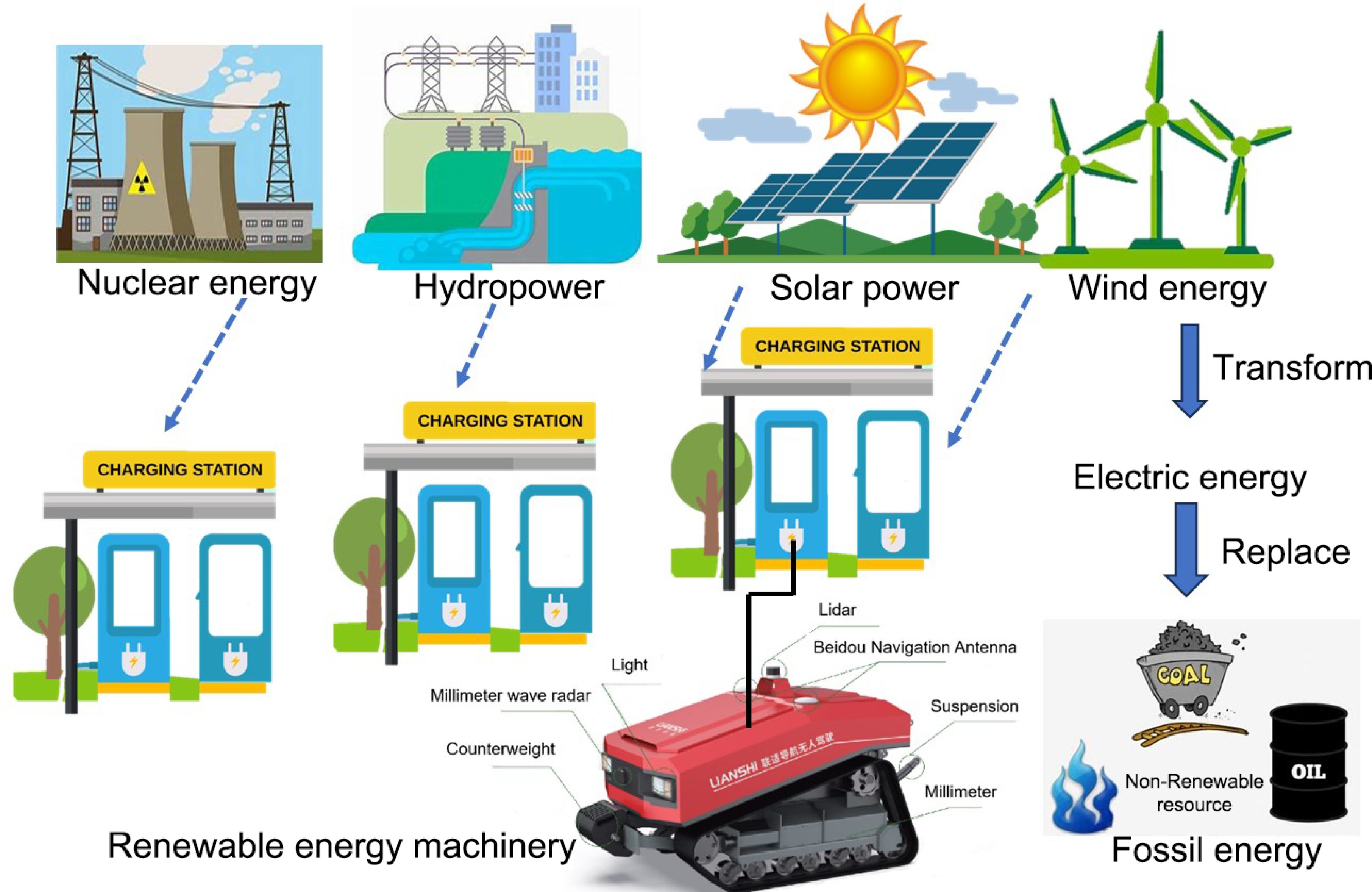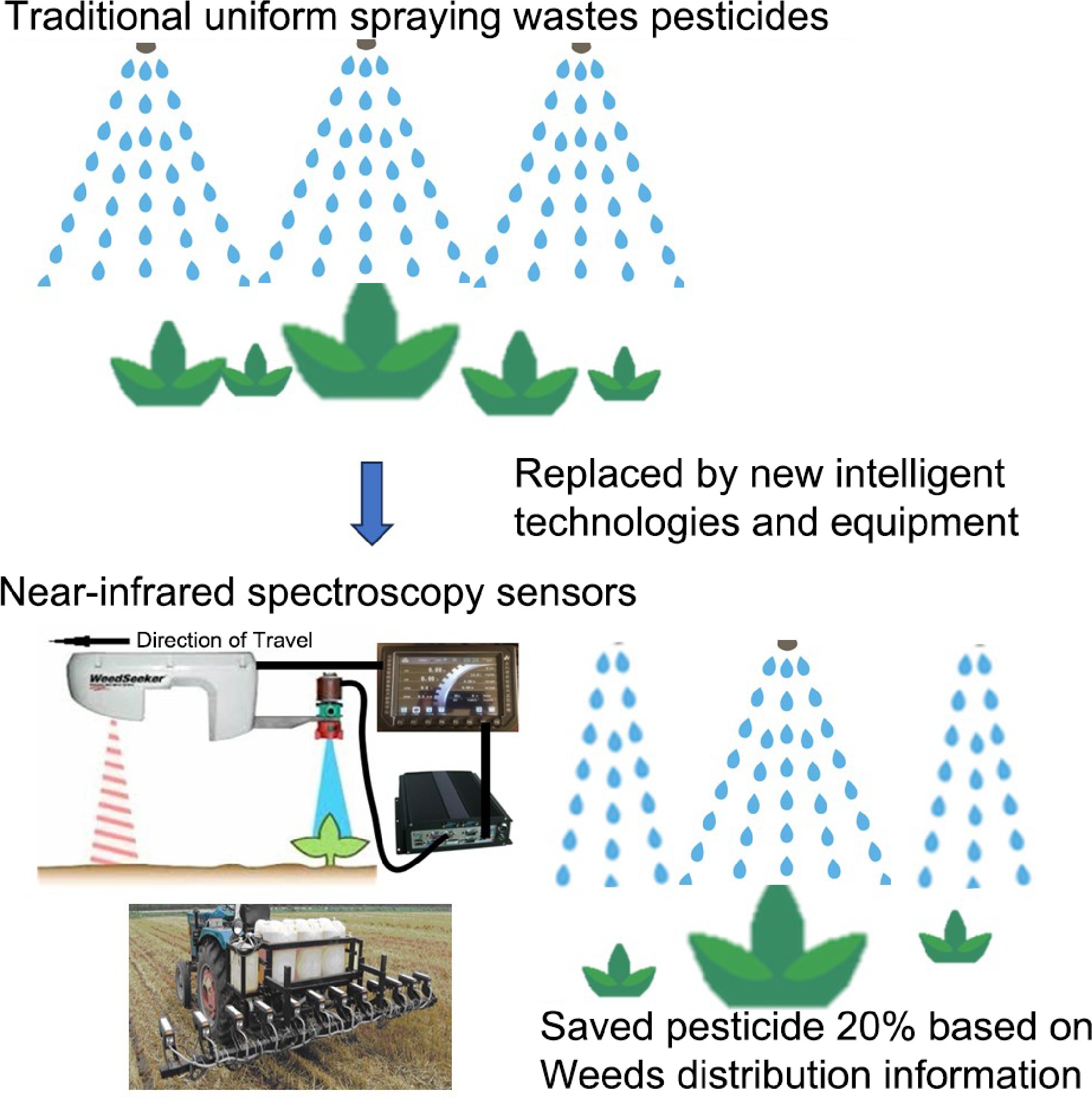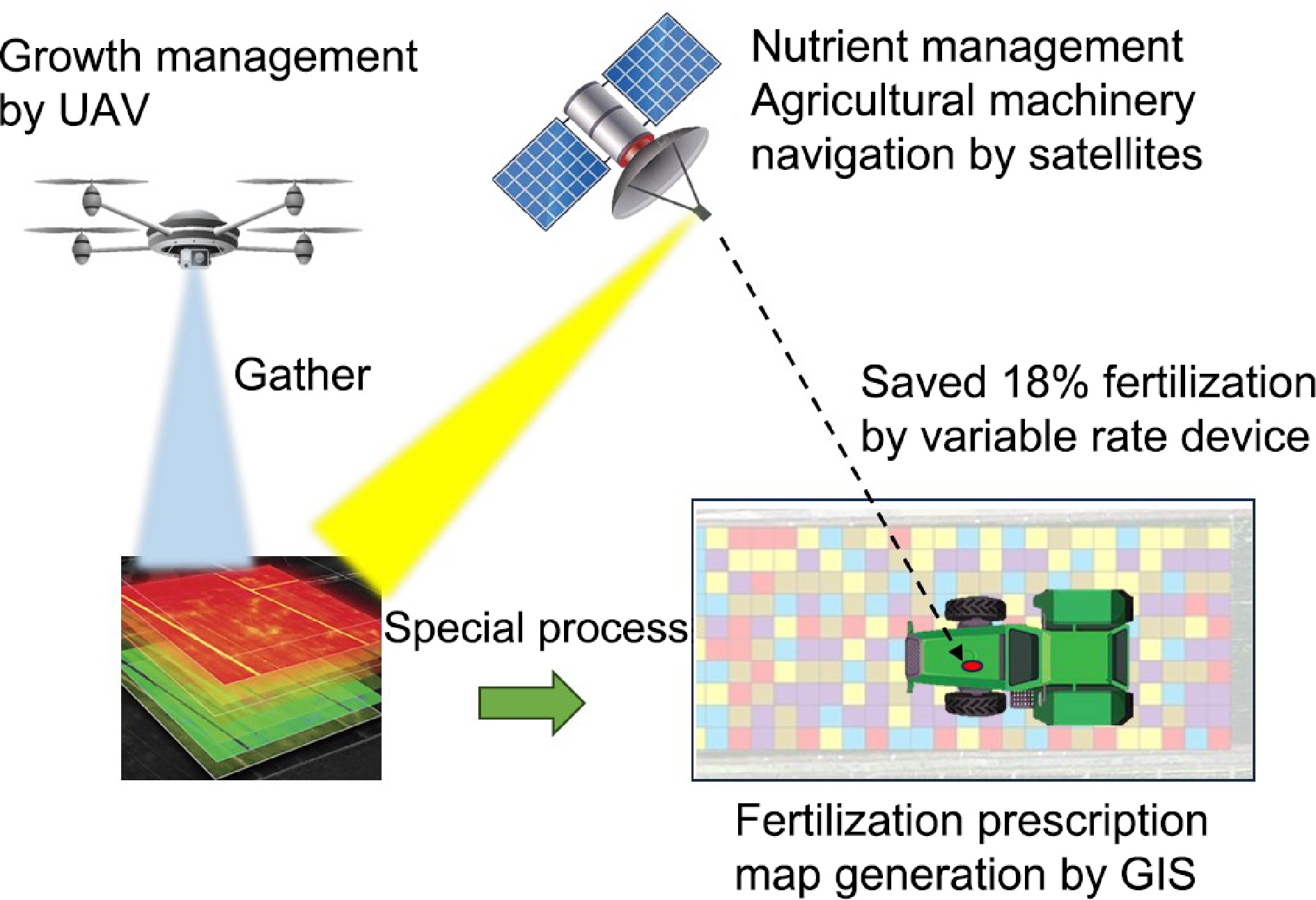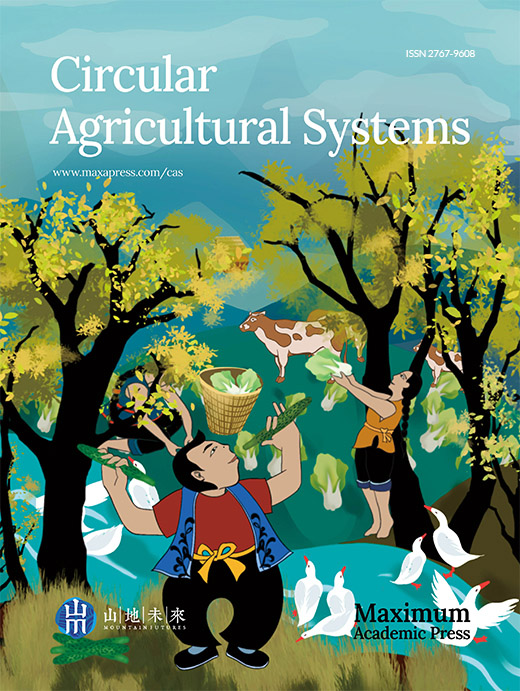-
It is known the Paris Agreement has been ground breaking in its efforts to obtain global involvement in combating climate change[1]. The agriculture system is the second largest source of greenhouse gas emissions (GHG) in the world, which accounts for about 14% of total greenhouse gas emissions in China, about 4% points higher than the world average[2]. In 2020, China formally proposed carbon peaking and carbon neutrality goals at the 75th session of the United Nations General Assembly, promising to achieve carbon peaking by 2030 and carbon neutrality by 2060. Considering the agriculture system contains both carbon sink and carbon source characteristics, much research has been carried out to explore solutions for effective carbon deduction and further neutralization in the last few decades. Besides, the emerging phenomenon of lack of labor availability in rural areas, which brings a new challenge for sustainable low carbon agriculture development in modern society.
With the rapid progress of artificial intelligence and the acceleration of urbanization, intelligent agricultural machinery has become an indispensable condition for sustainable agricultural development. Unlike traditional agricultural machinery, intelligent agricultural machinery fully utilizes newly developed green production technologies, promoting the rapid development of traditional agricultural machinery towards the framework of digitization, specialization, efficiency, automation, and informatization. In future, intelligent agricultural machinery will occupy over 80% of the total agricultural machinery ownership. It not only helps to improve the quality and yield of agricultural products, but also ensures low-carbon and sustainable development of modern agriculture, accelerating the process of agricultural modernization[3,4].
This article is structured into three parts as follows: the first part will illustrate major strategies in intelligent agricultural machinery system to decrease GHG emission; the second part will discuss potential barriers and opportunities by adopting intelligent agricultural machinery systems; the last part will provide implications for future unmanned farm development. The authors attempt to bring new insights to traditional agriculture systems from the perspective of intelligent agriculture machinery. Considering this topic is still under hot debate, we would like to encourage more studies to provide further evidence and further form a systematic study.
-
It is reported that a combination of plant biology, carbon capture techniques and novel bioconversion processes provided by third and fourth generation biofuel technologies have great potential to support the seventh goal − 'Affordable and Clean Energy' among the 17 goals of the Sustainable Development Goal (SDG)[5]. In this way, using biofuel as an alternative energy supply for agronomic machinery plays an important role in GHG emissions reduction. Biodiesel is one type of biofuel, which is made from unprocessed vegetable oils and animal fats, which have lower GHG emissions, lower pollution, lower prices and higher degradability compared to diesel[6]. The traditional agricultural machinery uses diesel as its main power, while new types of diesel engines for agricultural machinery are abandoning fossil fuels and adopting biodiesel. However, the comprehensive role of biodiesel in reducing carbon emissions in agriculture is still limited. Biodiesel engines can significantly reduce CO and HC, but increase nitrogen oxides by 10%. The rise in international oil prices has accelerated the progress of this alternative technology. The development of intelligent control technology for nozzle spray using biodiesel will accelerate its replacement[7,8].
Electric energy affects agricultural machinery for field operations
-
Besides climate change, the global environment change such as the Russia-Ukraine crisis has hit the grain production and exports of both countries hard, further influencing the food supply in other countries and resulting in potential food security and energy supply issues[9]. In order to cope this potential energy crisis in agronomic practices, other renewable energy (solar power) machinery is also developed. The battery industry is developing rapidly, and intelligent agricultural machinery is gradually replacing diesel engines with electric motors as power. Electric tractors, electric sprayers, and agricultural drones are all beginning to use high-density batteries as energy sources (as shown in Fig. 1). This change is beneficial for carbon emission reduction in agricultural production. But the issue that cannot be ignored is that carbon emissions objectively exist during battery production and battery destruction, which is normally considered as indirect GHG emission. There is also a battery lifespan issue that is related to the user's operating habits. For instance, improper charging can lead to damage to agricultural machinery, which is actually detrimental to carbon reduction[10,11].

Figure 1.
A typical representative of intelligent agricultural machinery is an intelligent electric tractor, which uses millimeter wave radar sensors, LiDAR sensors, and BeiDou satellite positioning system to achieve automatic walking. To realize the optimum operation path of intelligent agricultural machinery, the installed sensors and position systems can largely improve the field working efficiency. In this way, the required energy can decrease accordingly. A solar charging station built in the field can conveniently charge intelligent agricultural machinery. It should be noted that the high cost has prevented large-scale production of electric tractors.
Intelligent plant protection technology achieves pesticide reduction and efficiency improvement
-
The spraying prescription map generated by weed distribution information, which belongs to modern smart ecological agriculture category. It can greatly support the path navigation of agronomic machinery; furthermore, the tractors power saving contributes to an obvious pesticide usage decline of 20%. By analyzing the data detected by sensors, precision sprayers have the ability to accurately locate weeds in the ground and then spray herbicides on them (as shown in Fig. 2). This intelligent pesticide spraying agricultural machine has improved its operational efficiency by 3−5 times compared to traditional spraying machines, and the amount of pesticide used has been decreased by more than half (Ref). This technology is very helpful for reducing carbon emissions in agriculture by saving energy while reducing pesticide usage. The existing deficiency is the need for dedicated personnel to carefully maintain the optical sensors installed on agricultural machinery, accompanying the increase in cost due to the expensive sensors. Wei et al.[12] successfully developed a precise spraying machine that can recognize fruit trees in 2010. Over a decade of technological improvement has proven that this spraying machine can significantly increase efficiency, save pesticides, and prevent diseases, while achieving the goal of low-carbon agricultural production. The only drawback is that the cost of intelligent spraying machines is 6-8 times that of traditional spraying machinery. The price of smart sensors accounts for 65% of all costs. Nevertheless, domestically produced sensors will replace imported sensors within 3-5 years, and the cost issue will be significantly improved. In addition, the government will also provide a 30% subsidy for such agricultural machinery.

Figure 2.
Using near-infrared spectroscopy sensors for online detection, identify different types of weeds and wheat stubble, and based on the calculation results, control the spraying system in real-time to complete target spraying.
Agricultural machinery IoT technology improve fertilizer use efficiency
-
The Internet of Things (IoT) technology for agricultural machinery can obtain real-time trajectories and parameters of agricultural machinery field operations, and wirelessly send information to mobile phones and computers in offices 100 km away. This information is collected and processed by computer to achieve fertilizer prescription map, facilitating scientific soil fertility management. The intelligent fertilization machine automatically calculates the optimal fertilization amount and dynamically adjusts the fertilization amount based on historical yields and soil nutrients during its operation (as shown in Fig. 3). The precise control of fertilizer application based on crop growth is a dominant advantage, but the fact that complex mathematical models need to be established to control the fertilizer applicator to adapt to different crops is considered as its major drawback, which is very difficult for ordinary farmers to operate. The self-organized network of soil moisture sensors is established by a soil fertilizer prescription map. Moreover, the node position layout of soil moisture sensors and the soil fertilizer prescription coupling can maximize the integrated water and soil management efficiency.

Figure 3.
A satellite positioning system is installed to obtain the longitude and latitude coordinates of the tractor in the field. Based on the coordinate information, the fertilization amount in the fertilization prescription map is obtained. Then, a variable controller is used to accurately control the hydraulic motor speed, driving the outer groove wheel to accurately and quantitatively discharge fertilizer to the soil through the fertilization pipe. This design of on-demand fertilization is according to soil nutrients, which can greatly save fertilizer, ensuring stable yield and low carbonization.
Intelligent sowing can guide precision planting and maximize crop yield
-
The seeding system can automatically record the seeding trajectory information, knowing that the tractor follows the branch line to avoid overlapping and missed seeding issues (as shown in Fig. 4). The recorded sowing position can provide coordinate reference for subsequent weed control and fertilization operations. The intelligent and precise technology in the sowing process will cover the entire growth period of the crop. Ultimately, it promotes an increase in crop production by 18%−25%.

Figure 4.
An infrared sensor is used to detect the signal of seed falling and provide early warning for the blockage of the seeding tube, avoiding the problem of missed seeding. In order to achieve linear seeding and record the trajectory of the seeding, an automatic navigation system is applied. It can solve the problem of missed land seeding caused by overlapping seeding waste and excessive spacing. After recording the trajectory of sowing, the path can be downloaded to precision irrigation machines and precision spraying machines respectively. The subsequent management steps after sowing are based on straight-line sowing, which can greatly improve water and fertilizer utilization efficiency, meanwhile achieve low-carbon production.
-
The impact of intelligent agricultural machinery on carbon emissions is multifaceted. The continuous breakthroughs and maturity of core technologies in intelligent agricultural machinery can significantly reduce carbon emissions, such as fertilization and pesticide application technologies, which have a significant improvement effect of over 20% on improving efficiency and reducing the use of fertilizers and pesticides[13]. However, the contribution of intelligent agricultural machinery technology to carbon reduction is still constrained by the formulation of standards. If the application of intelligent agricultural machinery could not meet the standards, the results will contain great uncertainty. For example, improper use of electric agricultural machinery can cause great trouble due to battery pollution.
We would like to conclude that the impact of intelligent agricultural machinery on agricultural carbon reduction should be taken as a whole, to be specific, a life cycle perspective of agriculture system. It is inappropriate to exaggerate the role of intelligent agricultural machinery in a certain link, and we encourage evaluate the carbon reduction effect of intelligent agricultural machinery throughout the entire process from manufacturing to scrapping. The analysis results of the key technologies of intelligent agricultural machinery for carbon reduction are shown in Table 1.
Table 1. Intelligent agricultural machinery for carbon reduction.
Production
processKey technologies Intelligence level Cost Application scenario Assessment of carbon reduction potential Tillage Deep cultivation monitoring Very advanced General Grain and oil production Great potential Laser leveling Advanced General Grain and oil production Great potential Sowing Monitoring of seeding blockage Advanced General Grain and oil production Average potential Seeding overlap monitoring Advanced High cost Grain and oil production Average potential Cultivation Precision fertilization technology Very advanced General Grain and oil production; Great potential Fruit and vegetable production Target spraying of herbicides Very advanced General Grain and oil production; Great potential Fruit and vegetable production Harvesting Automatic recording of production Advanced High cost Grain and oil production Average potential Phased harvest General High cost Grain and oil production Great potential Transportation Internet of Things field scheduling General High cost Fruit and vegetable production Great potential Rough processing on farmland General High cost Fruit and vegetable production Great potential The assessments in the table are based on survey data and author experience. -
In the future, unmanned farms will use 100% intelligent agricultural machinery to replace traditional agricultural machinery. Intelligent agricultural machinery will complete production operations in five stages: cultivation, planting, management, harvesting, and transportation. An intelligent system will replace human grouping and formation of these intelligent agricultural machines. This type of unmanned farm will maximize low-carbon production and produce the healthiest food with the least resources, which is also the highest stage of urban agriculture.
Some successful cases are also worth our attention. Both the northern and southern regions of China have conducted exploratory research on the construction of unmanned farms. In 2019, the author participated in the establishment of a 12-hectare unmanned wheat farm in Xingtai City, Hebei Province (China), and received a 30% subsidy from the Hebei Provincial Government. Dayi County in Sichuan (China) has built a 1-hectare unmanned rice farm in 2022 and started accepting visits.
The main shortcomings of unmanned farm construction include a lack of international standards, low reliability of agricultural machinery, and a lack of overall scientific planning and management.
The development trend of unmanned farms in the future will mainly focus on the formulation of international standards, and the standard system will be the precondition of the development of unmanned farms.
-
Overall, intelligent agricultural machinery will play a significant role in the future development of agriculture. The role of intelligent agricultural machinery reflects both positive and negative sides. The positive aspect refers to the technological breakthrough and scaling up of intelligent agricultural machinery, which allows machines to replace human labor for the first time. The machines have ability to collect information, make intelligent decisions, and execute variables. On the other hand, the negative aspect is that the globalization of agriculture will be further enhanced through intelligent equipment, while the uniqueness and small-minority mode will become even weaker.
Firstly, the information collocation based on agricultural sensing and the agricultural Internet of Things. The ability to collect information, especially the precise collection of dynamic information such as climate, environment, soil, and crop parameters at a small scale in unstructured farmland, will become even more important. The dynamic transmission of information acquisition is crucial. Thanks to the development of low-cost agricultural IoT, this challenge will also be solved[14]. These real-time information collection methods provide the possibility for farmers to dynamically adjust agricultural inputs, improve efficiency, and minimize negative environmental impacts. In the precise management of wheat, the soil automatic sampling and nutrient management system developed by the authors has successfully solved the problem of lacking soil testing formula equipment. As a typical case, a large-scale demonstration application of more than 10000-hectare was conducted in Huaxian County, Henan Province (China), with a wheat yield increase effect of over 19%.
Secondly, the intelligent decision-making based on artificial intelligence and machine learning. Artificial intelligence (AI) and machine learning (ML) algorithms are used to analyze the vast amounts of data collected by intelligent agricultural machinery. These algorithms can identify patterns, make predictions, and provide actionable insights to farmers. These intelligent decision-making processes can be made in agricultural production processes without human subjective thought through models trained by scientists. By leveraging AI and ML, farmers can optimize crop management, reduce input usage, and improve overall productivity while minimizing negative environmental impact[15]. The unmanned farm fertilization machinery developed by the authors utilizes satellite images, drone images, and robot machine vision to achieve 'timing, quantification, and fixed-point' fertilization in the farm. As a classic case, it thoroughly solves the problem of excessive fertilization and soil quality decline in Dacaozhuang Farm, Xingtai, Hebei Province (China) over many years, simultaneously ensuring stable production and slightly increasing yield.
Thirdly, the carbon emission deduction by unmanned operation and agricultural robot variable execution. The variable execution process usually involves extensive application of robots and unmanned technologies, such as seedling cultivation, sowing, transplanting, grafting, fertilization, spraying, harvesting, logistics, warehousing, and sales. These machines can reduce labor intensity and improve working efficiency. Thus, farmers can use these machines to reduce potential carbon emissions to the environment[16].These machines can operate autonomously or be remotely controlled, reducing the need for manual labor and increasing field operation efficiency. By automating repetitive tasks, farmers can optimize resource allocation and reduce the overall carbon footprint during agricultural operation stages. In addition, the intelligent irrigation system developed by the authors can automatically control the fermentation of waste. Afterwards, using the fermented biogas slurry to cultivate potatoes and fruits. Then the potatoes are then processed into livestock fodder. As a case study, the authors utilized this circular system to completely solve the problem of the difficulty of the recycling of large-scale pig farming waste in Rongchang District, Chongqing Province (China).
It is worth noting that these typical cases have been replicated on a large scale to achieve precision production, carbon emission reduction, and production cost minimization. The accompanying side-effect is that some small-minority groups of cultivated old varieties might lose its niche and disappear in a round of intelligent technology iterations, which is unfavorable for agricultural crops' diversification protection.
-
The authors confirm contribution to the paper as follows: conceptualization, validation: Yang X, Tian Z; software, formal analysis, data curation, visualization: Yang X; writing—original draft preparation: Yang X, Ma W; investigation, writing—review and editing: Yang X, Tian Z, Ma W; resources, supervision, project administration, funding acquisition: Ma W. All authors have read and agreed to the published version of the manuscript.
-
The datasets generated during and/or analyzed during the current study are available from the corresponding author on reasonable request.
This work was generously supported by Key projects of Sichuan Provincial Science and Technology Plan (2022YFG0147), Chengdu Local Finance Special Fund Project for NASC (NASC2021KR02) and (NASC2021KR07).
-
The authors declare that they have no conflict of interest.
- Copyright: © 2024 by the author(s). Published by Maximum Academic Press, Fayetteville, GA. This article is an open access article distributed under Creative Commons Attribution License (CC BY 4.0), visit https://creativecommons.org/licenses/by/4.0/.
-
About this article
Cite this article
Ma W, Yang X, Tian Z. 2024. Agriculture neutralization: perspective from intelligent agricultural machinery. Circular Agricultural Systems 4: e002 doi: 10.48130/cas-0024-0002
Agriculture neutralization: perspective from intelligent agricultural machinery
- Received: 29 May 2023
- Revised: 28 December 2023
- Accepted: 30 December 2023
- Published online: 26 January 2024
Abstract: Against the background of climate change, exploring avoidable greenhouse gas emission from agriculture practices has gained public attention in the context of global energy transition. Intelligent agricultural machinery plays a crucial role in reducing carbon emissions in agriculture systems, and through the use of new energy, smart plant protection, and IoT technologies, carbon emissions can be significantly reduced. The focus of our debate is on the key role those intelligent technologies play, and what are the principles and shortcomings behind their effectiveness. What are the potential impacts of unmanned farms on agricultural carbon reduction and human survival issues in the future?












